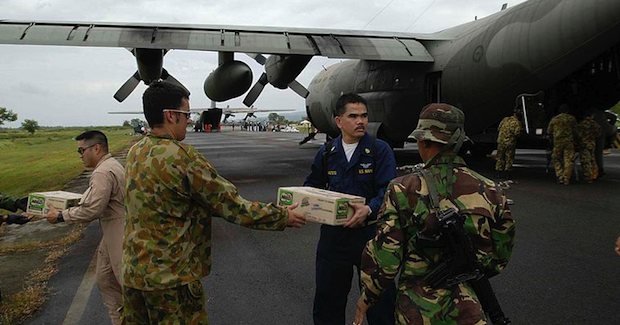The Challenge of Humanitarian Diplomacy

Humanitarian diplomacy is beginning to emerge as a more prominent element of states’ foreign policies, including Australia’s. It holds great promise but its practice can create tensions between humanitarianism and national interest. This ambiguity is particularly acute for Australia.
Humanitarian diplomacy provides states with a way of expressing important qualities of international empathy and solidarity that speak to fundamental human emotions. Such expressions of empathy and support not only enhance a state’s international reputation but provide valuable means for building relationship of trust and cooperation that can further a state’s broader foreign policy goal: enhancing the national interest.
But herein also lie some of the perils of humanitarian diplomacy. The positioning of humanitarian diplomacy within the broader structures of foreign policy may compromise the integrity of a state’s humanitarian action and in so doing inhibit rather than enhance a state’s international reputation and ambitions. The incorporation of humanitarian diplomacy into a state’s foreign policy can generate ambiguity and even tension.
What promises and perils does humanitarian diplomacy hold for Australia?
Australia and humanitarian diplomacy
Historically, Australia has strong credentials as a humanitarian actor. In the 19th century Australian organisations such as the Victorian Famine Relief Fund formed part of a network of Indian Famine Relief Committees created in response to the terrible famines in northern India in 1876–1878 with Australian groups contributing more than £50,000 (AU$70,960) to famine relief funds in 1877.
In its more recent past, Australia’s humanitarian track record includes the admission of some 150,000 refugees from Indochina in the late 1970s. Australia played leading roles in brokering the UN peace deal amongst warring factions in Cambodia 1991, in supporting and staffing the Peace Monitoring Group in post-conflict Bougainville in 1998, and in spearheading the INTERFET mission to Timor Leste and the Regional Assistance Mission to the Solomon Islands in 1999 and 2003 respectively.
As co-chair of the International Commission on Intervention and State Sovereignty, former Foreign Minister Gareth Evans was a key actor in the development of the doctrine of the Responsibility to Protect (R2P). Subsequently, Australian Prime Minister Kevin Rudd also played an important part in lobbying for the application of R2P to endorse UN-sanctioned intervention in Libya in 2011.
Australia’s humanitarian response to the 2004 Indian Ocean tsunami was rapid, multifaceted and substantial: AU$70 million was provided to affected countries in immediate assistance and reconstruction aid, and the delivery of medical and relief supplies was rapidly mobilised. In recent years, Australia has been working with partners in the region to build disaster risk reduction and resilience programs and to promote international mechanism in this field such as the Hyogo Framework Agreement and Sendai Framework for Disaster Risk Reduction.
At the same time, the profile of Australia as a highly engaged humanitarian actor has undoubtedly been compromised by recent cutbacks to its aid budget. Whilst Australia’s aid contribution peaked in 2012–2013, in May 2015 a $1 billion cut to the 2016–2017 aid budget was announced and a further $224 million announced in the 2016 budget.
The combined cuts over four years were estimated to constitute a 30 per cent fall in the Australian aid budget relative to its peak in 2012–2013. Such cuts to the broader aid budget will undoubtedly have an impact on the humanitarian and emergency aid budget.
According to the 2015 Global Humanitarian Assistance Report, in 2013 Australia had dropped from 9th largest donor of official humanitarian aid in the world to 13th, with humanitarian assistance dropping from US$499 million (AU$659.44 million) to US$338 million. This was at a time when global humanitarian assistance reached a peak of $28 billion in 2015.
Nevertheless it can be argued that Australia’s multifaceted humanitarian contribution illustrates its significant engagement with different dimensions of humanitarian diplomacy. It has mobilised resources to provide humanitarian assistance and afford protection: according to figures released by the Department of Foreign Affairs and Trade, between July 2014 and April 2015 Australia provided AU$127 million in emergency assistance to 15 crises.
It has acted to raise awareness of humanitarian needs, operating in bilateral, multilateral and poly-lateral fora, promoting humanitarian objectives such as humanitarian access, rescue, coordination and risk reduction; it has demonstrated leadership in terms of advocacy and negotiation humanitarian protection.
What are the incentives for its behaviour?
Attractive, but challenging
The pursuit of humanitarian diplomacy holds both promise and perils for any state. Whilst Australia does not go as far as Turkey in consciously articulating humanitarian diplomacy as a key plank of its broader diplomatic platform, its identity as a humanitarian actor and leader is important to its international persona.
But Australia is navigating a difficult course in its pursuit of humanitarian diplomacy. Norms of compassion and of solidarity with those in need—a willingness to offer a helping hand—form a significant component of national identity and are an important element of the nation’s ethos.
There is also a desire to express Australia’s unique agency as a promoter and supporter of humanitarian norms. Here then we see humanitarianism as mechanism within the state’s broader suite of diplomatic strategies; what I call humanitarianism as diplomacy.
At the same time diplomacy is also driven by the imperative to represent, protect and promote the national interest. Humanitarianism can provide a valuable vehicle for these tasks. However, when conceptions of interest are at odds with humanitarian diplomacy, perhaps not surprisingly the latter may well lose out.
However, humanitarian diplomacy is ultimately defined by treating the interests of those in need as primary, whereas when humanitarianism becomes a vehicle for broader diplomatic objectives, it is the national interests that gains precedence.
This can generate tensions and ambiguities that can compromise Australia’s capacity and indeed willingness to provide humanitarian assistance and protection impartially. Such compromises risk derailing Australia’s humanitarian diplomacy and undermining trust in it as a humanitarian actor.
Ironically this may undermine the credibility of Australia and thus the effectiveness of its pursuit of humanitarianism as a means to enhance the state’s reputation and national interests.
These issues are not unique to Australia; indeed all states face this dilemma. However, Australia’s sense of its national and international identity as linked to it being a compassionate country and good international citizen may make more acute the challenges of balancing humanitarian diplomacy with humanitarianism as diplomacy. How Australia navigates these challenges will influence significantly not only its international reputation but also its success in building relationships of trust and cooperation in the future, particularly with its neighbours in the region.
Jacinta O’Hagan is director of the Graduate Centre in Governance and International Affairs in the School of Political Science and International Studies at the University of Queensland and a former diplomat with the Irish Department of Foreign Affairs.
This article is an extract from her article in the Australian Journal of International Affairs, ‘Australia and the promise and the perils of humanitarian diplomacy’. It is republished with permission.




